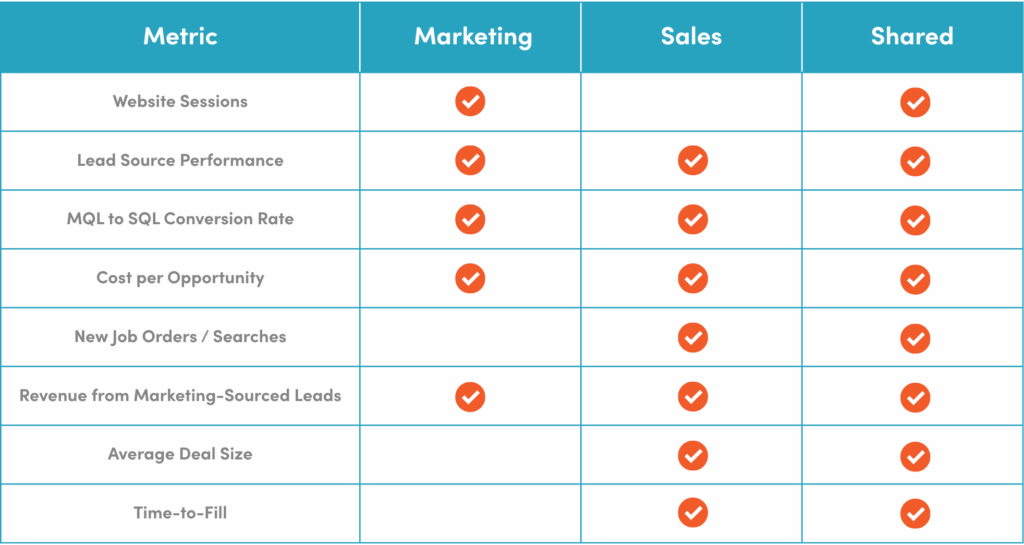How to Align Sales and Marketing in Staffing and Recruiting Firms

2025 isn’t playing by the old staffing rules. Single-digit growth (1% to be exact). Evolving tech. Changing buyer behavior. Shifting labor market dynamics. Everything’s in motion and the margin for error is razor thin. With so much on the line, staffing firms can’t afford misfires between sales and marketing. Integration, not just alignment, is the new imperative. When both teams are locked in and performing at their best, the payoff isn’t just smoother operations, it’s a real competitive edge.
But here’s the reality: in the staffing and recruiting industry, marketing is still too often an afterthought. Instead of being treated as a dedicated function, “marketing” is left to producers. Salespeople and recruiters are expected to create their own outreach, write follow-up emails, build collateral, and tell the firm’s story while also closing deals and filling jobs.
When echogravity gets the call, it’s often because there’s no structured marketing function in place. Producers are doing too much on their own—building email sequences, editing one-pagers, and juggling tasks that pull them away from sourcing and selling. To win more business, recruiters need marketing that amplifies their efforts, not competes for their time. Marketing should accelerate revenue, not add friction.
Another challenge exists when firms add marketing into the mix, the integration is rarely seamless. The two teams fall quickly into operating in silos, struggling to translate strategy into execution and messaging into market impact. The result? Missed opportunities, wasted resources, and a brand that doesn’t speak with one voice.
Let’s explore what actually works—and what doesn’t—when it comes to building synergy between sales and marketing in staffing:
What Can Go Wrong Between Sales and Marketing?
Even the most seasoned staffing leaders have experienced friction between sales and marketing. Here are some of the common pitfalls:
1. Separate Funnels and Misaligned Goals
According to a Gartner survey, 47% of sales and marketing professionals cited separate funnels as a primary reason for misalignment, leading to inconsistent lead handling and missed revenue opportunities. In staffing, this often means warm leads falling through the cracks because sales and marketing aren’t tracking candidates or clients the same way.
2. Communication Breakdowns and Lack of Shared Data
The same Gartner report highlights that 45% of respondents identified communication issues as a significant challenge, often exacerbated by siloed data systems that prevent a unified view of prospects and clients. For staffing firms, this often plays out when CRM and ATS platforms don’t talk to each other, or worse, when teams don’t talk at all.
3. Conflicting Leadership and Reporting Structures
Differing leadership hierarchies can create conflicting priorities with misalignment hindering cohesive strategy execution. In staffing, that might mean sales pushes job orders urgently while marketing focuses on talent brand or candidate pipelines, leaving both sides frustrated. Even when both functions report to the same executive, alignment isn’t guaranteed. Leaders often find themselves playing referee, lacking the time, or in some cases, the expertise to manage the nuanced tensions between short-term sales demands and longer-term marketing strategies. Without a clear, shared roadmap or consistent collaboration rituals, it’s easy for both teams to operate in silos, even under the same roof.
4. Commission Pressure vs. Marketing Timelines
In an industry where sales execs are often measured weekly, or even daily, against aggressive revenue targets, that pressure can contribute to dysfunction in a hurry. With commissions on the line, there’s intense sales focus on delivering qualified leads and filling roles fast. Meanwhile, marketing efforts can be more long-range, focused on building brand visibility, nurturing talent pools, or launching campaigns that take weeks to gain traction. When sales doesn’t see immediate ROI, frustration builds, especially when stakeholders expect near-instant results. That disconnect can quickly erode trust between teams if expectations and timelines aren’t aligned from the start.
How to Get the Best from Both Teams
A happy, harmonious, and most importantly, productive relationship between sales and marketing is possible. And the good news is, it’s not rocket science; it comes down to some key strategies.
1. Create a Unified Go-to-Market (GTM) Strategy
Bringing sales and marketing under one cohesive GTM strategy, ideally led by a single executive leader, ensures tighter coordination, clearer accountability, and more consistent execution. The goal is not just alignment but full integration. When sales and marketing work from a shared roadmap with unified leadership, they are better equipped to engage buyers at every stage of the journey, ultimately delivering a more seamless and effective customer experience. Leveraging an outsourced marketing team with staffing and recruting industry expertise can accelerate this process by bringing fresh insights, proven playbooks, and scalable execution that help build and sustain a high-performing GTM engine.
2. Implement Shared Metrics and KPIs
In a staffing and recruiting firm, shared sales and marketing metrics help align both teams around pipeline growth, lead quality, and revenue impact. Key shared metrics include MQL-to-SQL conversion rates, lead source performance, cost per opportunity, new job orders, and revenue from marketing-sourced leads. Additional joint KPIs like time-to-fill, average deal size, and touchpoints per opportunity ensure both teams are accountable for moving prospects through the funnel. When tracked consistently, these metrics bridge the gap between demand generation and deal conversion, driving more predictable growth.

3. Foster Regular Cross-Functional Communication
Schedule consistent meetings and collaborative sessions to review pipeline status, campaign impact, and real-time client and candidate feedback. In staffing, this ensures marketing supports urgent reqs and sales shares front-line insights that can shape future outreach. When you outsource your marketing function, these regular sessions have the additional benefit of nurturing a “one team” culture, ensuring your outsourced experts are viewed as, and can operate as, a true extension of your organization.
4. Leverage Technology for Integrated Workflows
Utilize CRM, ATS, and marketing automation tools that offer real-time visibility into client and candidate touchpoints. Integrated platforms like Bullhorn, Salesforce, or HubSpot allow sales and marketing to coordinate campaigns, track engagement, and respond faster to changing demand. The visibility and transparency inherent in sharing a platform will help eliminate silos, speed up decision-making, and ensure a unified message across all touchpoints.
A shared platform also removes any perceived distance between an outsourced marketing team and an internal sales team, enabling them to operate as one seamless go-to-market engine. An experienced outsourced marketing partner will bring deep expertise in optimizing campaign performance, interpreting analytics, and maintaining data hygiene, all of which enhance visibility and trust. Their ability to execute quickly and strategically within the shared system not only boosts efficiency but also builds credibility with the sales team. With everyone working from the same source of truth, collaboration improves, feedback loops tighten, and the relationship evolves from transactional to truly strategic.
5. Eliminate Duplication
Sales folks don’t need to (and frankly, shouldn’t) write campaign copy. (Not because they can’t but because that’s not the kind of immediate revenue-generating task that needs to be at the top of their task list.) They do need to trust marketing’s expertise, share buyer insights, and give real field feedback.
On the flip side, marketing team members shouldn’t dictate sales scripts or over-engineer the outreach process. When marketers try to control conversations that happen one-on-one with clients, it can slow momentum and dilute the authentic voice that sales brings to the table. Each team should do their own heavy lifting to drive results: sales owns the relationships and conversions, marketing owns the message and lead generation. The magic happens when both functions bring their strengths to the table and stay in their lanes, aligned but not entangled.
How Sales Can Lean into Marketing
Sales teams can amplify their performance by leaning into marketing’s capabilities. This includes using persona-based content to tailor outreach, providing real-time feedback on what messaging is landing in the field, and actively participating in campaign planning to ensure revenue targets are achieved. Engaged sales teams can also help drive better marketing outcomes by sharing insights from client conversations that uncover emerging pain points or buying trends. When done right, this creates a feedback loop that sharpens campaigns and accelerates conversions.
For the sales-marketing relationship to thrive, both teams must respect the unique expertise the other brings. It’s important to understand that, as a function, marketing serves sales, but let’s not mistake that to mean marketing is subservient to sales. Marketing professionals invest deeply in brand positioning, campaign performance, and audience analytics. These are essential marketing skills that require strategic foresight and creative discipline. Sales professionals, on the other hand, understand customer objections, deal cycles, and on-the-ground needs in ways that no dashboard can fully capture. When both recognize the value each function provides, collaboration becomes not only possible, but powerful.
Marketing and Sales Integration Isn’t Optional Anymore
Ultimately, whether your marketing team is in-house or outsourced, they should be more than a support function. They should be the engine driving sales success. When aligned and integrated, marketing fuels your pipeline with qualified leads, delivers the insights that sharpen sales strategy, and scales the outreach that drives revenue. If your team isn’t operating this way yet, let’s talk about how to get there.